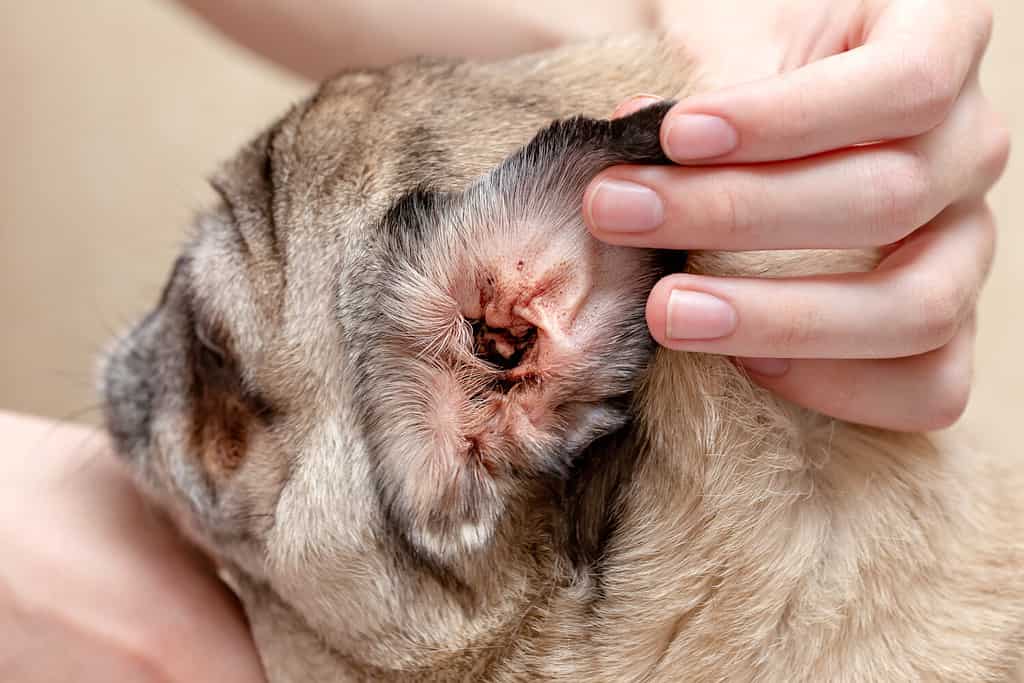Does your furry feline friend seem unusually bothered by constant ear scratching and head shaking? It might be those pesky ear mites causing all the commotion! These minuscule critters that infest your cat’s ear canal are a common nuisance amongst our whiskered companions. These creepy crawlies can be itchy and irritating, causing your cat significant discomfort and distress. But don’t worry; with a little know-how and some simple steps, you can swiftly and effectively tackle this problem. But first, let’s look at what causes ear mites in cats.
What Causes Ear Mites in Cats?
Ear mites in cats are caused by tiny parasites known as Otodectes cynotis. These minuscule creatures are a common problem among felines and can lead to uncomfortable and bothersome symptoms. The mites are primarily found in the ear canals of cats, where they thrive in warm and moist environments.
The transmission of ear mites occurs through direct contact with an infected cat. It can also spread through contact with contaminated objects, such as bedding or grooming tools. Stray and outdoor cats are at a higher risk of contracting ear mites. This is because they often come into contact with other infected animals.
Once the mites infest a cat’s ears, they feed on the skin debris and ear wax. This causes irritation and inflammation in the ear canal. This irritation leads to symptoms like constant scratching of the ears, head shaking, and rubbing against objects. As the infestation progresses, the cat may also develop secondary bacterial infections due to the broken skin from excessive scratching.
Does My Cat Have Ear Mites?
A veterinarian must examine the cat’s ears thoroughly to make a diagnosis of ear mites. In general, the procedure is easy and painless. The veterinarian will first ask about the presence of any symptoms, such as ear scratching, head shaking, or abnormal behavior.
As part of the subsequent physical examination, the vet will pay special attention to the cat’s ears. An otoscope, which is a hand-held device with a light and magnifying lens, may be used to inspect the ear canals. This allows them to identify any signs of ear mite infestation. Some signs include dark brown, crusty discharge resembling coffee grounds, or the presence of the mites themselves.
The veterinarian may collect a small sample of the ear fluid or debris to examine under a microscope to confirm the diagnosis. This method is useful for identifying ear mites, ear mite eggs, and other microbes that might be to blame for the symptoms.
If you believe your cat has ear mites, you must take them to the vet immediately. Attempting a diagnosis and treatment at home without training or experience increases the risk of making the problem worse.
With all of this in mind, let’s dive into the many different treatments one can try to get rid of ear mites in cats.

Ear mites can cause infection in both cats and dogs, so they must be treated quickly.
©Glikiri/Shutterstock.com
Ear Mite Treatment #1 – Prescription Medication
Prescription medication is an effective and essential treatment for ear mites in cats. This is due to its targeted approach and ability to eradicate the mites and alleviate the associated discomfort. Ear mites are tiny parasites that infest a cat’s ear canals, causing irritation and inflammation. Over-the-counter treatments may not always be sufficient, making prescription medication the preferred option.
Medication prescribed for ear mites in cats is designed to eradicate both the parasites and their eggs. They can be applied topically to the ear canal, as ear drops or ointments, or taken orally. Effectively disrupting the mite life cycle and protecting against new infestations, these treatments contain active components that target the mites’ nervous system or reproductive activities.
The use of prescription medication ensures proper dosing and treatment duration, as recommended by a veterinarian. This approach is critical as under-dosing or incomplete treatment can lead to mite survival and resurgence of the infestation. Moreover, prescription medications are generally safe when used as directed, minimizing the risk of adverse effects on the cat.
Effective treatment with prescription medication can quickly alleviate the uncomfortable symptoms associated with ear mites, such as itching, head shaking, and ear discharge. By eradicating the mites, the risk of secondary infections caused by excessive scratching is also reduced.
Treating Additional Symptoms
Another advantage of prescription medication is its ability to tackle other possible ear problems that may coexist with the mite infestation. Veterinarians can identify and address these issues during the examination. They can then prescribe appropriate medications to treat them simultaneously. This promotes faster recovery and prevents further complications.
While over-the-counter products may seem like a cost-effective option, they may not be as potent or suitable for treating more severe ear mite infestations. Relying on prescription medication ensures a more reliable and comprehensive treatment. The medication also increases the likelihood of a successful outcome and a happier, healthier cat.
Ear Mite Treatment #2 – Ear Drops
Ear drops are an effective and convenient treatment for ear mites in cats, offering targeted action and ease of application. These tiny parasites, known as Otodectes cynotis, infest the ear canals of cats, leading to irritation and discomfort. Ear drops are specifically designed to combat ear mites and address the associated symptoms, making them a preferred choice for treatment.
The active ingredients in ear drops are formulated to directly target the mites and disrupt their life cycle. When applied directly into the cat’s ear canal, the drops reach the affected area more efficiently, ensuring maximum effectiveness. The drops work by either attacking the mites’ nervous system or interfering with their reproductive processes, ultimately leading to their demise and preventing further infestations.
One of the significant advantages of using ear drops is the ease of application. Most cats may not be fond of having their ears handled, but with a gentle and careful approach, applying the drops can be a relatively straightforward process. Veterinarians or pet owners can administer the drops at home, eliminating the need for frequent vet visits and reducing stress for the cat.
Ear drops also offer a quicker and more direct solution to the problem compared to oral medications. By targeting the mites at the source, ear drops can swiftly alleviate itching, inflammation, and any associated discomfort. Prompt treatment with ear drops can prevent the cat from excessively scratching the ears, reducing the risk of secondary bacterial infections.
Also, ear drops can be part of a comprehensive treatment plan. Veterinarians can recommend a combination of therapies, including cleaning the ears to remove debris and applying ear drops to kill the mites. This approach ensures a more effective and holistic treatment, addressing the infestation and any other possible ear issues that may coexist.
Ear Mite Treatment #3 – Ear Cleaners
The primary function of ear cleaners is to gently clean the ears and eliminate accumulated dirt and debris. By doing so, they create a cleaner environment that hinders the mites’ ability to thrive and reproduce. Additionally, removing excess wax and debris can aid in the effectiveness of other medications, such as ear drops, by allowing them to penetrate the ear canal more efficiently.
Regular ear cleaning can also help prevent secondary infections that may arise due to excessive scratching and irritation caused by the mites. By keeping the ears clean and dry, the cat’s natural defense mechanisms can better combat potential pathogens.
Most cats accept ear-cleaning treatments rather well, provided that they are performed calmly and with a gentle touch. Ear-cleaning is an important part of ear mite treatment, and it also allows cat owners to be actively involved in their pet’s healing and rehabilitation. When ear cleaning is part of the cat’s regular care, it’s much simpler to notice any decline or improvement in the animal’s ear health.
Furthermore, ear cleaners can provide immediate relief from itching and discomfort for the cat. The process of cleaning the ears can soothe irritation and promote a sense of comfort, especially when combined with other prescribed treatments. This can lead to a happier and more contented cat throughout the recovery process.
It is essential to use veterinary-approved ear cleaners specifically designed for cats. Using inappropriate products can worsen the condition or cause further irritation. Veterinarians can recommend suitable ear cleaners and provide instructions on the correct technique for safe and effective cleaning.
Ear Mite Treatment #4 – Systemic Medications
Ear mites in cats are sometimes difficult to cure, but systemic medications offer a thorough solution by attacking the infestation and the possible infection from the inside out. Systemic drugs, in contrast to topical therapies and less-intensive medications, are taken orally or injected, allowing the active components to spread throughout the body via the bloodstream.
One of the significant advantages of systemic medication is its ability to tackle ear mite infestations that may extend beyond the ear canal. Ear mites can sometimes spread to other areas of the body, such as the head, neck, and paws. Systemic medication ensures that mites in these areas are also addressed, preventing further infestations and potential complications.
The nervous system or metabolism of the ear mites is the focus of systemic treatment, which successfully disrupts the life cycle and stops the mites from reproducing. This aids in reducing the mite population and controlling the infestation, which leads to the complete eradication of the mites from the cat’s body.
When cats aren’t cooperative or have extreme sensitivities to topical therapies, systemic medications can be a real lifesaver. It is generally simpler and less unpleasant for both the cat and the owner to administer systemic medicine, ensuring that therapy is carried out properly and without causing unnecessary suffering.
A veterinarian’s examination and diagnosis are required before prescribing systemic drugs. Based on the infestation’s severity and your cat’s particular health needs, your doctor will establish the proper dosage and length of therapy.
Ear Mite Treatment #5 – Follow-Up Treatments
Follow-up treatments are essential for effectively treating ear mites in cats and ensuring a successful recovery. Ear mite infestations can be persistent. Follow-up treatments play a vital role in eradicating any remaining mites and preventing re-infestation.
After the initial treatment, follow-up appointments with the veterinarian are crucial to monitor the cat’s progress and assess the effectiveness of the treatment. The veterinarian will examine the cat’s ears to check for any signs of lingering mites or signs of improvement. If necessary, they may adjust the treatment plan or recommend additional measures to address any remaining mites.
In some cases, follow-up treatments may involve administering additional doses of prescribed medication. Completing the full course of treatment is crucial to ensure that all mites are eradicated and to prevent the development of resistance to the medication.
Ear Mite Treatment #6 – Cleaning House
These types of mites can be effectively treated by cleaning your cat’s living space in addition to using medication. Ear mites on a cat can quickly spread to the cat’s environment, infesting the cat’s bedding, toys, and other belongings. Regular cleaning helps get rid of mites and stops them from coming back, making the home healthier for the cat.
Ear mites develop rapidly in warm, humid places like your cat’s ears, but that can also include where your cat spends their time. You can limit the number of mites and disrupt their life cycle by thoroughly cleaning and disinfecting your home. Mites and their eggs may be removed from a home by vacuuming the carpets, washing the bedding, and disinfecting the surfaces using products designed for use with dogs.
Preventing Reinfestation
Frequently cleaning your cat’s living area is also essential to prevent re-infestation. Even if you treat your cat’s ears with medication, mites can quickly return from the surrounding environment if it remains infested. A thorough and regular cleaning routine can break the cycle of infestation. Thus, you can ensure that your cat is not re-exposed to mites.
Cleaning also helps to improve the overall hygiene of your cat’s living space. It reduces the risk of other infections and health issues. When ear mites infest a cat, they can cause the cat to scratch excessively. This can lead to skin lesions and potential secondary bacterial infections. A clean and well-maintained living area can minimize the risk of such complications.
Just as well, cleaning your cat’s living area demonstrates care and responsibility as a pet owner. It shows that you are committed to providing a clean and safe environment for your feline friend’s well-being. Regular cleaning can also be an opportunity to inspect the living area for any signs of mite activity or other potential problems, allowing you to address them promptly.
Ear Mite Treatment #7 – Preventative Measures
Preventative measures play a crucial role in effectively treating ear mites in cats. This is because prevention stops the infestation before it occurs. Being proactive in preventing ear mite infestations can save the cat from discomfort and potential complications.
Regular ear checks are an essential preventative measure. By inspecting your cat’s ears regularly, you can identify any early signs of mite infestations, such as excessive scratching or head shaking. Catching the problem early allows for prompt treatment and reduces the chances of the infestation spreading and causing further irritation.
Maintaining good hygiene is another vital aspect of prevention. Regularly cleaning your cat’s living area, including bedding and toys, can help prevent mites from establishing themselves in the environment. Keeping the area clean and dry discourages mites from thriving and reproducing.
Limiting your cat’s exposure to potential sources of infestation is also crucial. Avoiding contact with stray or infected animals can help reduce the risk of transmission of mites to your cat. If your cat does come into contact with other animals, it’s essential to monitor their ears closely for any signs of mites.
Routine veterinary check-ups are an essential preventative measure. During these visits, your veterinarian can examine your cat’s ears and detect any early signs of mite infestations. Regular check-ups also provide an opportunity to discuss preventive measures and address any concerns you may have.
Thank you for reading! Have some feedback for us? Contact the AZ Animals editorial team.








